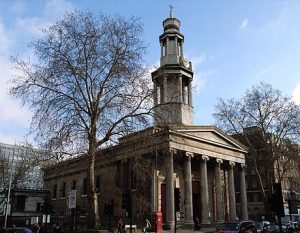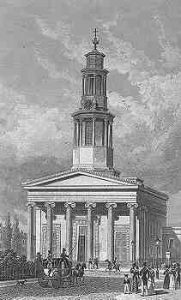St Pancras New Church was hugely expensive, costing £77,000. The money was raised by increasing the rates by the maximum possible of 4d to raise £40,000. The rest of the money came from loans. The church cost so much because of its size and architectural ambition. Once completed it could hold 2,500, and the crypt was built to hold 2,000 interments, though by 1854 when burials inside London churches were ended only 500 bodies had been placed there.

The church was designed by William Inwood and his son, Henry William Inwood who were leading exponents of the Greek revival. At the east end are two porticos, with that on the north side facing Euston Road being the most visible and which is one of London landmarks. These together with the nave are modelled on the Erectheion on the Acropolis in Athens. The two porticoes are dominated by the caryatids, or female figures supporting the roofs, which are closely based on the Athen originals.
However, the London versions unlike the orginals now on view in the Acropolis Museum carry symbols of mortality – upturned torches and funerary urns. The west front itself is again derived, albeit rather loosely from the Erectheion, with six Ionic columns supporting a triangular pediment, and with this portico giving access to three large doors. Above this front is a tower, which in a departure from the tower-less Erectheion, is derived from the Tower of the Winds in the Roman Forum in Athens.

The church was built in 1819-22, when there was urgent need for increased parochial provision due to London’s expansion. The parish of St Pancras was huge, centred on St Pancras ‘Old Church’, which lies to the north of St Pancras station. The parish extended as far as Oxford Street to the South and to Highgate in the north. The construction of the New Road (now Euston Road) was a major catalyst for urban development in this area. An impression of how large the old parish was is given by its division into 33 new parishes when London’s ecclesiastical administration was reformed in 1890.
Though large in size and built to provide Christian instruction in a rapidly expanding parish, the church with its expensive architecture was really designed with the well-to-do rate-payers who financed it in mind. The highly fashionable building stood on the eastern side of the then-fashionable Euston Square.
Book tickets for Ian’s Euston to King’s Cross Walking Tour




